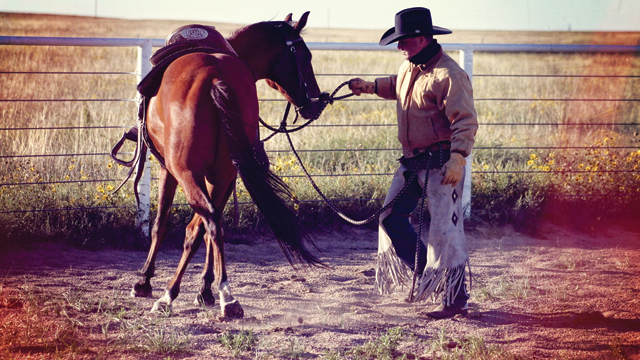This article originally appeared in issue #75. Subscribe Today!
Quite often questions come up related to the problems people have catching, haltering, bridling, saddling, mounting their horse and so on. When the person is asked to demonstrate the way that they go about getting the job done, what I see is the horse is being offended by their method.
Quite often the person is focused too much on the task at hand. For example, they are so focused on getting the bit in the horse’s mouth that they don’t notice that the headstall is gouging his eye, or pulling the whiskers on his muzzle or pinching his ear as it gets folded up. A horse will be taking in all of our movement and the way we are affecting him. The problem is that we get tunnel vision and may only see part of what is happening. What we do with a horse may not always be a good experience for him or he may not like it, but we can at least minimize the discomfort and do it in a less offensive way.
A horse goes through different stages prious, which is a very productive srocessing or evaluating things we present him with. He can be cutate because he is taking a lot in and evaluating in a non-threatened way. During this state his attention span can vary depending on age and previous experiences. This is a very good place to operate from and we should maximize these productive opportunities. In order to maintain his curiosity, there would be nothing we are doing that would be offensive to him.
Another state is taking flight. This can be anything from jumping away from us and running away or just raising his head trying to avoid us. This is a state that it’s very important to calculate the effect we are having on a horse. We will likely end up here at some point, and it may not be avoided, but the important thing is, what the horse comes away from this state with. This is where the slightest pressure or offensiveness needs to be noticed and calculated. By releasing the discomfort and helping him find relief we can create the optimum learning experience and be the most productive, in my opinion.
Another state is when a horse tolerates what is happening to him. He is not liking it but he is not trying to escape. He can be accepting something without any confinement or restriction, or he can acknowledge some restriction and resent what is taking place without fighting or taking flight.
And finally there’s a comatose state where the horse releases the natural painkilling drug into his system and gets that glazed over look in his eye. At this point, he is to some extent incoherent. You may get some accomplishments here but it’s a very unproductive learning state of mind for a horse.
Horses like being comfortable; they don’t like being threatened. This is basically the pressure relief system that horses learn from. If a horse can experience discomfort or pressure, then we can show him relief, or comfort. Then he is motivated to look for the comfort when he is faced with that pressure next time.
The more we can see things from the horse’s perspective, the better we can understand what he’s feeling and then we may be able to adjust things accordingly to fit him better. So look at your horse and see if he seems offended by your approach. He will tell you if you should be making some adjustments.


